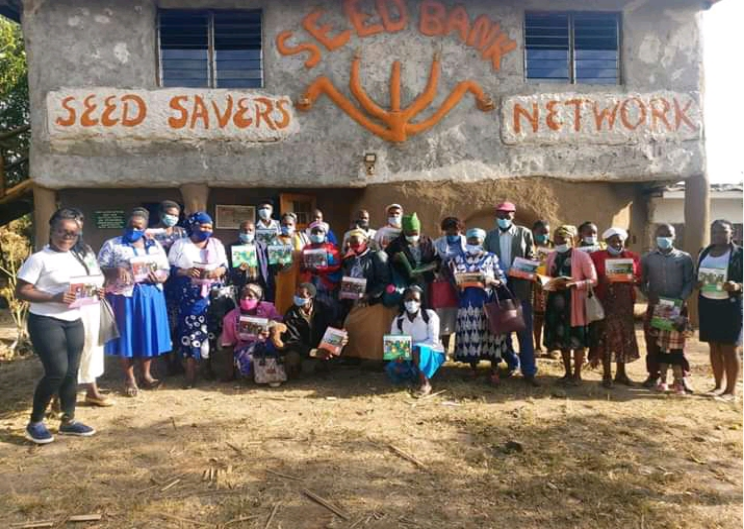Author: Julia Kamau (Seed Savers Network Kenya)
Introduction
With 80 percent of the Kenyan economy being agriculturally-based, Kenya is considered a farming nation. Most of the husbandry in Kenya is dependent on rain even though four-fifths of the country is arid and semi-arid. Historically, the most popular food crops among the different communities have been those that can withstand long periods of drought. Among farming communities in Kenya, legumes are an important source of nourishment, and are, therefore, central to many diets in the country. Most of the grown legumes are from traditional varieties and not F1 hybrids; therefore, farmers use their saved seeds either from personal stores, friends or networks of farmers. According to Bationo et al. (2011), farmers in Kenya are reluctant to buy certified legume seeds because their vigour declines after two or three generations, which inhibits replanting of saved seeds. KenInvest (2020) estimates that between 75 and 95 percent of legume seeds come from retained seeds or seeds from other farms. There are two classes of legumes in Kenya; indigenous legumes, some of which have cultural significance such as the dolichos (Njahi), cowpeas, green peas, and pigeon peas; and second, those introduced into the country from exotic sources such as Britain as cash crops, such as French beans.
Important legumes in Kenya
Please find the informations about the important legumes in kenya here.
Role of legumes in the Kenyan diet
Source of protein
Legumes are an important source of protein, which makes them a viable substitute for dairy and meat products, as the latter can be expensive for some Kenyans or may not be an option for vegetarians. Substituting beans for beef is also linked to a lower risk of lifestyle disease as the former has no saturated fats and contains low iron levels. Soybean is used to make porridge as it is considered highly nutritious.
Source of fibre
Legumes are an important source of fibre and are low in calories, which creates a filling sensation for long after consumption. There are concerns that obesity levels in Kenya have been on the rise. Thus, as more and more people switch to healthier lifestyles to avoid obesity and associated lifestyle diseases, legumes play a role in offering healthy nutrition to Kenyans.
Protection from Diseases
Legumes are rich in antioxidants which help repair damaged cells, slow the process of ageing and fight diseases. Lentils, soybean, peas and other legumes are rich in fibre, packed with Vitamin B and E and proteins as well as flavonoid compounds. According to a medical research done by Zhu, etl 2015, they found that regular consumption of legumes can help prevent digestive cancers such as Colon and Colorectal and reverse the effects of lifestyle diseases such as blood pressure and high sugar levels. Perhaps, the rise of lifestyle diseases in Kenya stem from the fact that most of the traditional staple legumes have been abandoned (Muthoni and Nyamongo, 2010). For example, black dolichos beans have been found to reduce blood sugar, increase eye health and prevent cancer.
Source of easy-to-prepare food
Given that many legumes are eaten cooked fromtheir dried form, they are relatively easy to prepare, which makes them a low-cost source of nutrition. The most common format of preparing legumes is by boiling after which they can be eaten alone or mixed with other types of grains such as maize to make githeri (a corn and bean one pot meal which originated from the Kikuyu tribe of Kenya) or potatoes to make a stew.
Legumes such as French beans and pigeon peas can be eaten in their pod offering additional ways to prepare the food for variety, which is attractive for young children. Groundnuts are a popular snack in their roasted form found in almost all shops within the Kenyan communities.
Source of fertilityfor other staple crops
Legumes are an excellent source of nitrogen, which is a crucial component in the vegetative growth of most crops. Traditionally, legumes have been intercropped with other staple foods primarily maize and sorghum as doing so results in better yields for both crops especially given environmental constraints such as drought and poor soils.
In soils with low fertility, legumes provide nitrogen and soil cover, which enhances fertility, and eventually, contributes to a balanced diet within a community.
Legumes and the Kenyan economy
Despite their many benefits and roles in society, grain legumes are considered a ‘poor man’s food’, which limits their broader consumption within the rapidly growing middle class in Kenya (Onyango, 2017). The Kenyan middle class, which is defined as individuals with an annual income of over $3900 accounts for approximately 45 percent of the population (Voigt, 2018). While most of the market in Kenya is highly price-conscious, the middle class is attractive to businesses because they pursue product-quality and build loyalty. The perception that legumes are primarily consumed by the lower-classes is further supported by the absence of knowledge about the importance of legumes as a low-cost source of proteins, antioxidants and fibres. Without appropriate campaign to raise awareness, some crops such as the dolichos and cowpeas are facing chances of being neglected and underutilised despite the potential to alleviate not only hunger but also lifestyle diseases. As Seed Savers Network Kenya, we are committed to encouraging our farmers to grow and consume most of the neglected and underutilised legume varieties. According to KenInvest (2020), the undercultivation of legumes has left a deficit of up to 40 percent, which necessitates importation to fill the gap. In their research about the economic role of legumes in the country, Onyango (2017) suggests that proper development of the legume value chain also can support economic growth through income generation for farmers and promotion of food security.
Most of the legume farming in Kenya is done by women yet in the majority of households in production areas, income is controlled by men. As Seed Savers Network, Kenya we are working to empower the women and ensure they embrace their traditionally owned legume varieties for a nutritionally secure home as we work to boost their economic footing through agroecology farming.
Reference List
Baraka, C. 2021. The Njahi Wars: Behind Kenya’s Controversial Black Bean. https://www.seriouseats.com/njahi-wars-kenyan-black-beans-5184204.
Bationo, A., Waswa, B., Okeyo, J. M., Maina, F., Kihara, J., & Mokwunye, U. (Eds.). 2011. Fighting poverty in sub-Saharan Africa: the multiple roles of legumes in integrated soil fertility management. Springer Science & Business Media.
Duku C, Groot A, Demissie T, Muhwanga J, Nzoka O, Recha J. 2020. Common beans Kenya: Climate risk assessment. Climate Resilient Agribusiness for Tomorrow (CRAFT).
KALRO. 2022. Beans, Kalro.org. Available at: https://www.kalro.org/csapp/index.php?option=com_content&view=article&id=29&Itemid=310 (Accessed: 7 February 2022).
Karanja, D.R., Githunguri, C.M., M’Ragwa, L., Mulwa, D. and Mwiti, S., 2006. Variety Characteristics and Production Guidelines of Traditional Food Crops. https://www.kalro.org/sites/default/files/Traditional-food-crops-manual.pdf
KenInvest. 2020. Pulses Sector Investment Profile. Available at: https://www.intracen.org/uploadedFiles/intracenorg/Content/Redesign/Projects/PIGA/Kenya_Pulses_booklet_20201102_web.pdf (Accessed: 7 February 2022).
Muthoni, J. and Nyamongo, D.O., 2010. Traditional food crops and their role in food and nutritional security in Kenya. Journal of Agricultural & Food Information, 11(1), pp.36-50.
Onyango, M.A., 2017. An Economic Analysis of Grain Legumes Utilization and Gross Margins in Nandi County, Kenya (Doctoral dissertation, University of Nairobi).
Seed Savers Network, Kenya, 2021. Farmers Preparing Kikuyu Food from Their Own Garden. https://www.youtube.com/watch?v=DVos-kXMzWA
Zhu B, Sun Y, Qi L, Zhong R, Miao X. Dietary legume consumption reduces risk of colorectal cancer: evidence from a meta-analysis of cohort studies. Sci Rep. 2015 Mar 5;5:8797. doi: 10.1038/srep08797. PMID: 25739376; PMCID: PMC4350074.




